
|
||||||||
|
Mid-water trawl The mid-water trawl is usually much larger than a bottom trawl and designed to fish off the seabed, in mid water. Otter boards maintain the horizontal opening. Floats on the headline (at the top) and weights on the groundline (at the bottom) maintain the vertical opening. Mid-water trawl gear is used to target species such as blue grenadier off western Tasmania. |
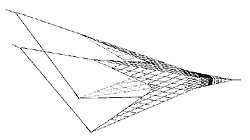 |
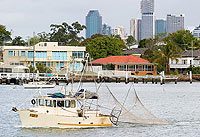 Prawn trawler in the Brisbane River (courtesy of John Mewett via Flickr) |
Prawn trawl Prawn trawl nets are similar to bottom otter trawls but do not use sweeps. Chains are hung below the footrope to disturb the prawns, causing them to ‘jump’ into the path of the oncoming net. A single vessel commonly tows arrays of two, three or even four such nets. Prawn trawling of this type is generally limited to waters shallower than about 80m. Danish seine Danish seine nets are a cross between a trawl net and a seine net, in terms of shape. The line and net is laid out in a pear shape and then hauled back to the stationary or slowly steaming vessel in a similar fashion to a bottom trawl. The two lines act as ‘sweeps’, herding fish towards the net. Danish seine gear is used on the continental shelf to target flathead, whiting and morwong. |
Scallop dredge Scallop dredges are mainly box-shaped, mud dredges, up to 3.5m wide, dragged along the seabed, digging into the substrate to collect animals on and within it. Scallop dredges are used in relatively shallow continental shelf waters, to a depth of 100m. Pole and line Surface-swimming schools of tuna are attracted to the fishing vessel using live or dead bait. The tuna, in a frenzy of feeding, take a barbless hook and lure and are hauled aboard using a pole and short, fixed line. Pole and line may be combined with purse seining to attract and aggregate a school of fish, around which the net is set. The pole boat subsequently escapes over the top of the purse seine net. |
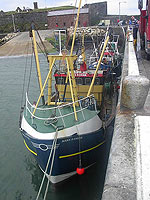 Scallop dredge (courtesy of Eric Galloway via Flickr) |
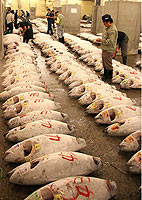 Tuna, just caught, waiting to be sold (courtesy of Paul Emery via Flickr) |
Pelagic longline Pelagic longlines comprise a mainline suspended horizontally by floats. Branch lines, each with a single baited hook, are attached to the main line at regular intervals. The line is allowed to ‘soak’ for several hours before retrieval. Pelagic longlines are used to catch tuna and billfish in oceanic waters and usually hooks are set shallower than 300m. Dropline A dropline is a single main line, with numerous baited hooks (usually no more than 100) attached to the bottom portion of the line via branch-lines and clips. The main line is set vertically in the water column, between a large surface float and a bottom weight. Droplines are regularly set to depths greater than 500m and catch blue-eye trevalla and hapuku among other species. |
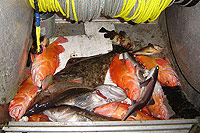 A longline fishing catch (courtesy of Gary Hartford via Flickr) |
Troll lines are run from the stern (rear) of the vessel and from booms on the side of the vessel. Hooked baits and lures are pulled through the water behind the moving vessel. Trolling is used to catch tuna and mackerel in coastal waters and waters off the continental shelf.
Bottom longline
A bottom longline consists of a mainline, with attached branch-lines and hooks, which are set across the seabed. Variations can have floats incorporated to lift the baits away from the bottom. Bottom longlines are used to catch ling and school shark among other species.
Squid jig Squid jigging occurs at night, with bright lights attracting squid to the vessel’s side. Lines with several barbless lures are ‘jigged’ up and down and squid caught on the lures are hauled onto the vessel. Most squid vessels in Australia use automated, mechanical jigging machines. Squid jigging occurs mainly in coastal waters. Acknowledgement This information has been modified from the publication Marine Matters produced by Bureau of Rural Sciences (BRS). |
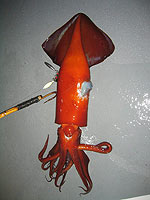 Squid jig (courtesy of Jake Bjeldanes via Flickr) |
